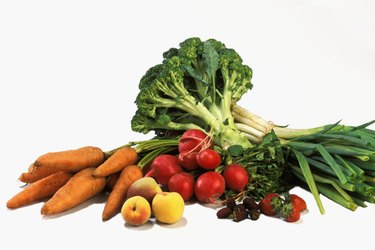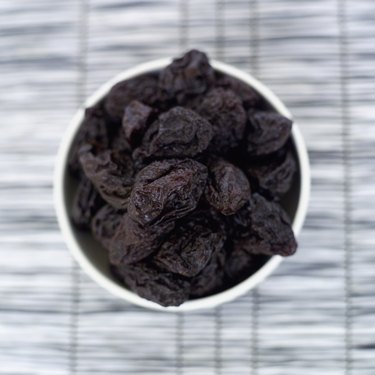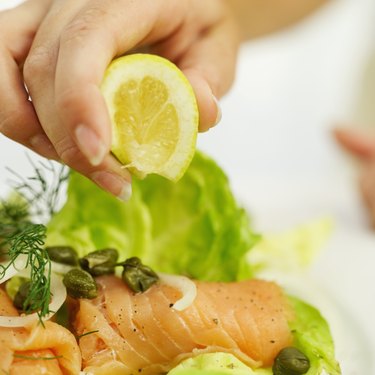
Fruits, vegetables and fish should be the basis of any healthy diet. Together they provide essential vitamins and minerals, fiber and lean protein. To ensure that you get the proper nutrients while on a diet, eat a variety of colors of fruits and vegetables, as well as different types of fish. Many diet plans, such as the Mediterranean, Dietary Approaches to Stop Hypertension, or DASH, and the Therapeutic Lifestyle Changes, or TLC, not only include these foods groups as a base, but also include healthy whole grains as well.
Colorful Vegetables
Video of the Day

Each vegetable has a unique set of nutrients. For example, red peppers contain vitamin C, while carrots get their orange color from beta carotene. The 2010 Dietary Guidelines for Americans recommend vegetables in a variety of colors, with a focus on dark green, red and orange vegetables, and beans and peas. To get the recommended minimum intake of 2 1/2 cups for women and 3 cups for men, make sure at least one quarter of your plate is vegetables.
Video of the Day
Nutritive Fruits

Whole fruits, not fruit juice, provide fiber, which will help you to feel full on fewer calories. Fruit and fruit juices are a natural source of sugar, which gives you energy. Fruits provide many nutrients that are underconsumed, including potassium, vitamin C and folic acid. Adult women and men need 2 cups of fruits each day, so make room on your plate at meals and snacks, and try a variety of fresh or frozen fruits. Eat canned fruit in moderation -- and avoid varieties canned in syrup -- and watch your portion sizes when eating dried fruit, because it's high in calories.
Protein-Packed Fish

Fish provides lean protein, which is the building block for muscles, enzymes, hormones and vitamins. Adult women need 5 to 5 1/2 ounces and men need 5 1/2 to 6 1/2 ounces of protein foods each day, depending on age. Three ounces is a typical serving of fish, with the protein amounts varying among varieties. The highest-protein fish is tuna at a total of 26 grams per 3-ounce serving, with swordfish at the low end at 16 grams for the same size serving. Some fish also provide omega-3 fatty acids, which can decrease triglyceride levels, slow the growth of plaque in the arteries and slightly lower blood pressure. The American Heart Association recommends that you consume two 3.5-ounce servings of salmon, mackerel, herring or tuna, which provide Omega-3s.
Other Food Groups
A healthy diet can include all food groups, even carbohydrates like whole grains. Magnesium, which is important in releasing energy from muscle, and selenium, which supports a healthy immune system, are just two of the nutrients found in whole grains. Aim to make at least half -- if not all -- of the grains you eat whole. Choose from whole grain wheat, oats, brown rice or quinoa.
- Bell Institute of Health: Veggie Tales: What You Should Know About Vegetables
- United States Department of Agriculture: How Many Vegetables Are Needed Daily or Weekly?
- Dietary Guidelines for Americans, 2010: Foods and Nutrients to Increase
- United States Department of Agriculture: Why it is Important to Eat Fruit
- United States Department of Agriculture: How Much Fruit is Needed Daily.
- United States Department of Agriculture: Why Is It Important to Make Lean or Low-Fat Choices from the Protein Foods Group
- United States Department of Agriculture: How Much Food from the Protein Foods Group is Needed Daily
- Food and Drug Administration: Cooked Seafood Poster
- United States Department of Agriculture: Why Is it Important to Eat Grains, Especially Whole Grains
- American Heart Association: Fish and Omega-3 Fatty Acids